This article was recently published in Motorhomes, Caravans and Destinations Magazine
Heather Whelan finds there’s plenty to do in Cambridge – come rain or shine
 |
St Andrews Church |
We’ve always wanted to spend more time in Cambridge, and visited twice last year. Our first attempt was hampered by rain but undeterred, we picked up a ‘Rainy Day Activities’ brochure at the i-SITE and headed down Victoria Street.
We soon discovered several antique shops filled with interesting objects of desire. On nearby Duke Street there were some op shops, where things had smaller price tags. I was interested to learn that the Lions Club hold a Trash and Treasure Market every second Sunday of the month, advertised as having over 200 stalls.
 |
Antique treasures |
HISTORY, HERITAGE AND HORSES
Avoiding a downpour, we scurried into Cambridge Museum, once the courthouse. This was a little gem, full of items relating to Maori, pioneer European, and horse racing history. We learned how the town was established – it once rivalled Hamilton as Waikato’s major settlement. We studied items including a copy of a newspaper written in te reo, dated 1894, and treasured pieces brought from England by early settlers to the district. A porcelain teapot, made in the late 1700s, came from a village near my birthplace in England. I found it amazing that it had survived the journey across the world: it must have been a precious possession.
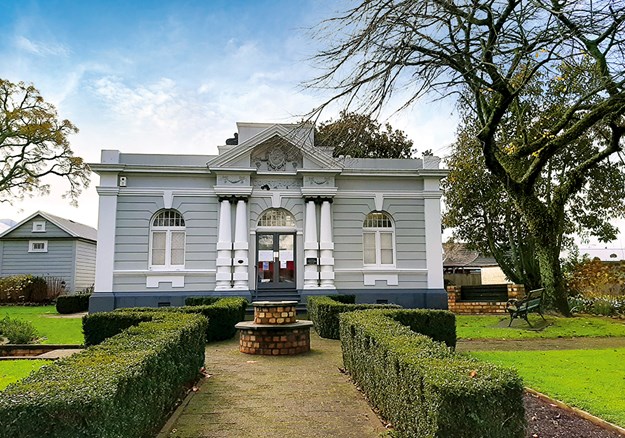 |
Cambridge Museum |
Cambridge is famous for its thoroughbred horses: 13 Melbourne Cup winners have been bred here. Outside the Town Hall there’s a life-sized bronze statue of a mare and foal. Set into the footpaths, mainly along Victoria Street, is a series of 22 mosaics of horses – the most famous being Olympic champion Mark Todd’s Charisma.
 |
Horse mosaic |
DOWN BY THE RIVER
Making the most of some sunshine, we continued along Victoria Street and made our way down to the banks of the Waikato River. The cliffs were sheer and the descent to river level was by way of a steep wooden staircase. We walked the loop track that linked two bridges and took us through bush and past waterfalls. The walkway on the town side is known as the Settlers Track, and leads to the junction of the river with the Karapiro Stream. Steamers carrying passengers and freight used to turn around here, having travelled from Port Waikato.
 |
Victoria Bridge |
Crossing the bridges to the south bank, we passed through a kauri grove, and then followed the Soldiers Track to Victoria Bridge. From below we had admired this meccano-like structure spanning the river. We were interested to learn that the bridge was the first hinged, arched bridge to be built in Australasia. The components were made in New York and shipped to New Zealand. Photos on the information panels beside the bridge show crowds celebrating the opening in 1907. There are horse-drawn carriages waiting to cross, though cattle and pedestrians were the main users in those days. (Stock commonly crossed it en route to sale yards until the 1960s.) But times were changing and a newspaper noted that "motor cars are becoming almost as numerous as stray cows". A pedestrian footpath was later added and, with another rain shower imminent, we hurried across the bridge and back into town.
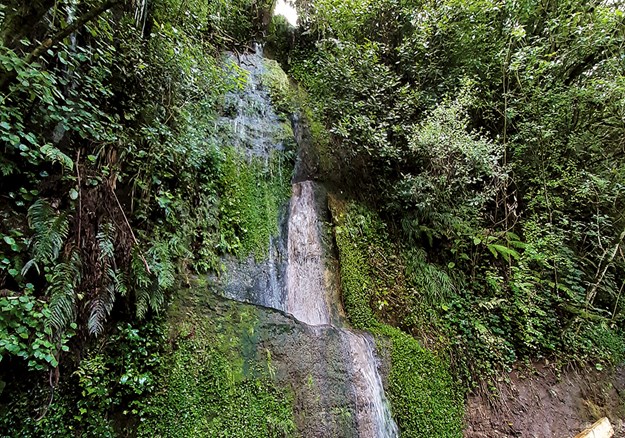 |
On the Settlers Track |
FOODIE & SHOPPING PARADISE
On our second visit, sunny, pre-Christmas Cambridge had a different vibe; the shops, galleries and cafes were festively busy. Malcolm dived into Over the Moon, a cheese shop and deli. The award-winning cheeses here are made by Over the Moon Dairy Company, who handcraft cheese from cow, sheep, goat and buffalo milk. Then we headed to Fran’s Cafe, the unpretentious home of good coffee and food – and more teapots than I’ve ever seen in one place. We’d discovered Fran’s on our previous visit and the food was just as good this time.
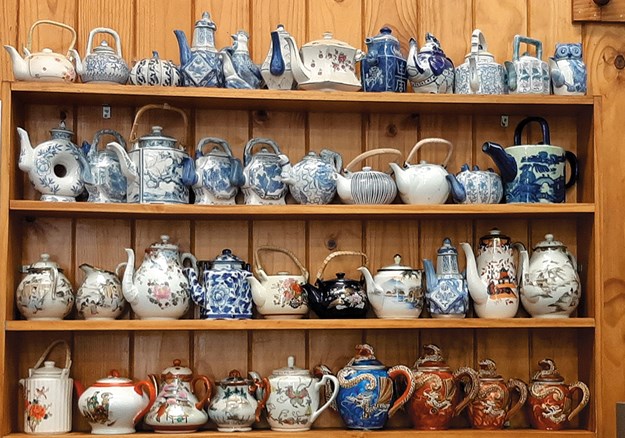 |
Teapots galore at Fran’s cafe |
THE HIDDEN LAKE
It was perfect weather to explore one of Cambridge’s best-kept secrets, Lake Te Ko Utu. Because the lake nestles below street level, it’s easy to drive past without realising what’s tucked out of sight.
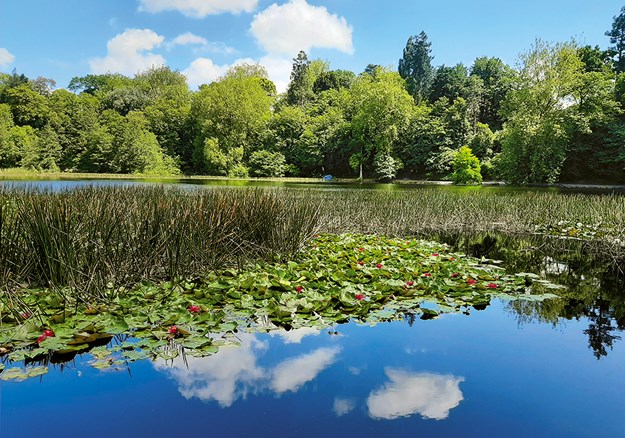 |
Lake Te Ko Utu |
The lake (also written as Te Koutu and Te Koo Utu) was formed when the eruption from Lake Taupo in 200 AD sent debris down the Waikato River, blocking side streams. Te Ko Utu translates as ‘to scoop up water’: the lake was used by Maori who lived at the adjacent pa. Now it is home to ducks, pukeko and coots (and their chicks).
There are gates on Whittaker Road, marking the entrance to the Domain, home to the bowling club, tennis club, gardens, bandstand and other clubrooms, as well as the lake. We had parked our bus on Lake Road and entered the Domain there, walking around the lake at the lower level, admiring the aquatic life and the exotic and native trees.
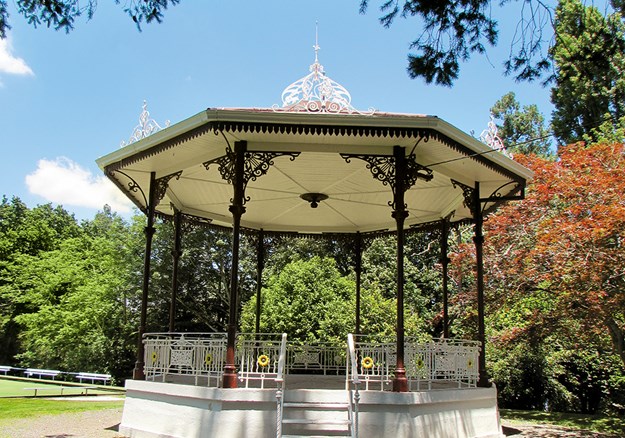 |
The band rotunda |
TOWN OF TREES
Cambridge markets itself as the Town of Trees and Champions – early settlers planted many elm, chestnut, oak, plane and gum trees in the town and around the lake. The Cambridge Tree Trust and the Lions Group have done a lot of work labelling trees, building viewing platforms, planting, and caring for the mature trees. Notable species include cedar of Lebanon and kauri. In 1962 a camellia grove was planted.
We enjoyed our circuit of the lake so much that we returned to the higher level and took a path that looped around past the Edwardian bandstand and sports clubs. The bandstand, built in 1908 from a kitset shipped from Glasgow, peeked out above a swathe of rose bushes.
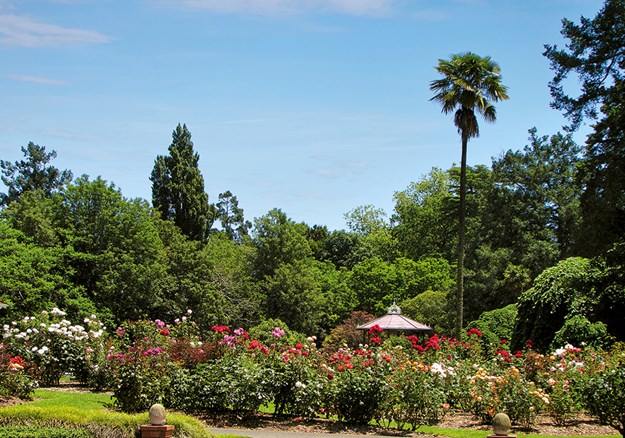 |
The rose gardens |
CHURCHES AND CIDER
Cambridge is blessed with many historic buildings and churches. St Andrews Anglican Church looked like a picture postcard, framed by the trees at the entrance to the Domain. Built in 1861, it contains a peal of six bells and a WW1 memorial window commemorating New Zealand soldiers climbing the walls of Le Quesnoy, France, in the final weeks of the war. The red letterbox beside the church has been used since 1898.
It was another church that drew our attention though. The old Trinity Presbyterian St Pauls Union Church is now home to the Good Union Restaurant. We couldn’t resist the cider brewed by Good George Brewing. I had the Doris plum and Malcolm opted for blood orange. The food was equally delicious.
At the museum we’d picked up brochures, including a walk around the town’s heritage buildings. But we felt we’d done enough walking this hot day, so we drove the bus to the POP where we were staying and relaxed for the rest of the afternoon. There’s so much more to discover in Cambridge though, I’m sure we’ll be back.
MORE INFORMATION
There’s a TOP 10 Holiday Park at 32 Scott Street, Leamington, Cambridge, and for NZMCA members POPs (Park Over Properties) are available. Visit nzmca.org.nz for details. Cambridge i-Site is on the corner of Queen and Victoria streets.







